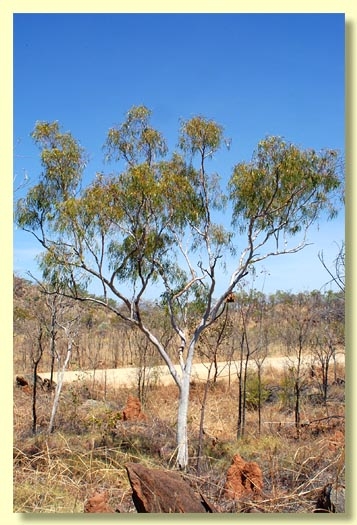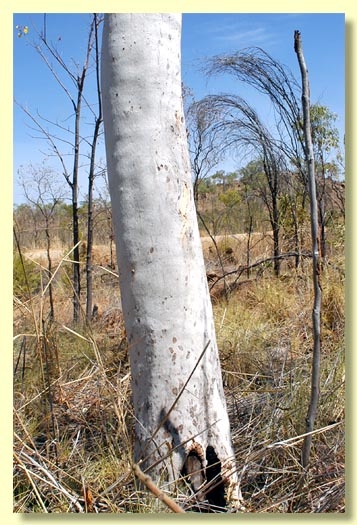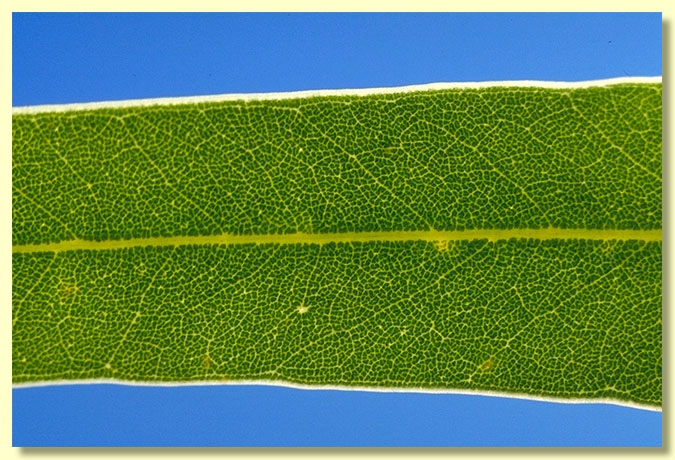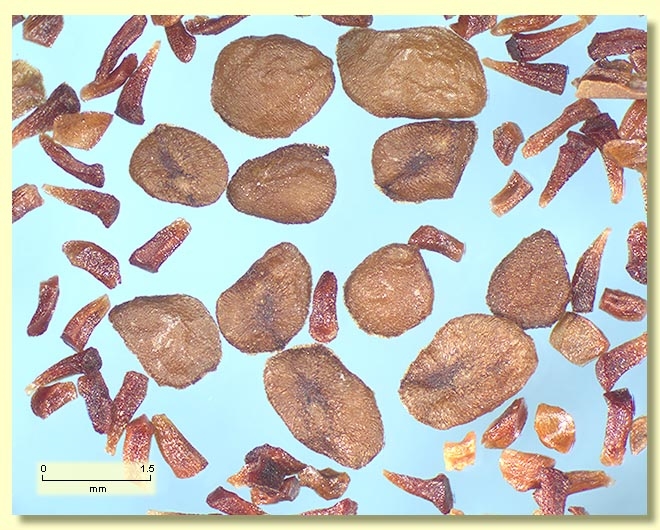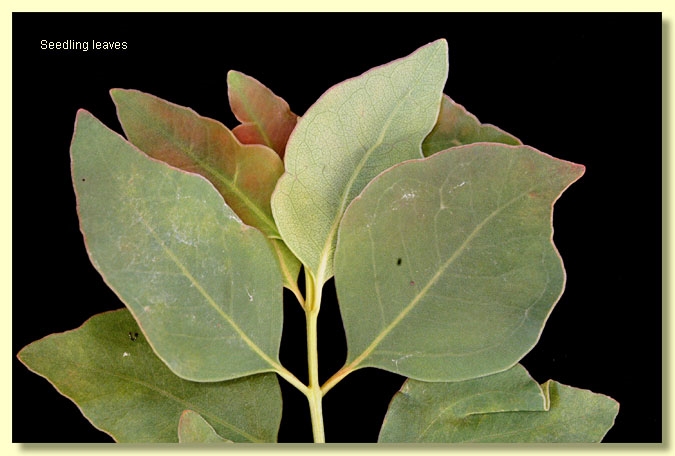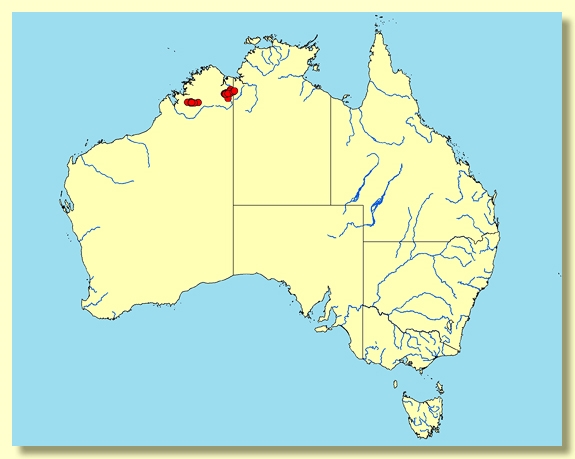Euclid - Online edition
Eucalyptus confluens
Eucalyptus | Symphyomyrtus | Platysperma
Tree to 8 m tall, sometimes with drooping or pendulous branches. Forming a lignotuber.
Bark smooth throughout, powdery white over pale pink, weathering in patches to grey.
Juvenile growth (coppice or field seedlings to 50 cm): stems square in cross-section, non-glaucous, smooth; leaves sub-opposite to alternate, petiolate, orbicular to broadly ovate, 4-7.5 cm long, 3-4.5 cm wide, base rounded to tapering, rarely truncate, apex rounded to broadly pointed, dull green.
Adult leaves alternate, petioles 1–2.5(3.3) cm long; blade lanceolate to rarely falcate, 6–15(17) cm long, 0.9–2.2 cm wide, base tapering to petiole, margin entire, apex pointed, concolorous, glossy, green, side-veins acute, less than 45° to the midrib or rarely at a wider angle, reticulation dense to very dense, intramarginal vein close to margin, oil glands apparently absent.
Inflorescence axillary unbranched, peduncles 0.4–1.0 cm long, buds 7, sessile to shortly pedicellate (pedicels 0–0.2 cm long). Mature buds obovoid to ovoid to globular, 0.5–0.8 cm long, 0.3–0.5 cm wide, non-glaucous, scar present, operculum rounded to bluntly conical to rarely slightly wider than the hypanthium (0.2–0.4 cm long), hypanthium often with 2 longitudinal ridges, regularly to irregularly inflexed, anthers oblong, versatile, dorsifixed, dehiscing by longitudinal slits, style long and straight, stigma blunt, locules 3(4), the placentae each with 6 or more vertical rows of ovules. Flowers white.
Fruit sessile to shortly pedicellate (pedicels 0–0.1 cm long), cup-shaped to hemispherical to rarely truncate-globose, non-glaucous, 0.4–0.7 cm long, 0.6–0.7 cm wide, disc broad, level to sometimes slightly raised, valves 3(4), near rim level or slightly exserted.
Seeds brown to yellowy brown, 1.5–2.2 mm long, flattened-ovoid, dorsal surface shallowly reticulate, edge of seed smooth, hilum ventral.
Cultivated seedlings (measured at ca node 10): cotyledons oblong-reniform, sometimes shallowly indented at the apex; stems square in cross-section; leaves always petiolate (petioles 0.5–1 cm), opposite for ca 8 or 9 nodes then alternate or persisting as opposite for 13+ nodes, ovate to broadly so, 3.2–7 cm long, 2–4.5 cm wide, base rounded to broadly tapering, dull, green, concolorous.
Flowering has been recorded in March and October.
A small tree restricted to the stony rises and hills of the Kimberley region of Western Australia and the adjacent Northern Territory. There are two disjunct populations, one in the King Leopold Range area of the western Kimberley and another in the Lake Argyle area of the eastern Kimberley, with this population just extending over the border into the Northern Territory. Characterised by smooth powdery white bark, glossy green adult leaves and fruit with a broad flat or slightly ascending disc.
Eucalyptus confluens belongs in a group of species that are distinguished by having smooth bark, very dense reticulation in the adult leaves and flat, flattened-ovoid, non-toothed, pale yellow-brown to brown seeds with a ventral hilum. The other members of this group are E. kenneallyi, E. umbrawarrensis, E. rupestris, E. leucophloia, E. brevifolia and E. ordiana.
Within this group, E. confluens is closely related to E. brevifolia. Both have fruit with a broad flat to slightly ascending disc. They can be separated on the sheen of the adult leaf. E. confluens is glossy, while E. brevifolia is dull. Another species in this group with glossy green adult leaves is E. umbrawarrensis and it is easily separated from E. confluens by the disc of the fruit, which is narrow and descending in E. umbrawarrensis and broad and flat or slightly ascending in E. confluens. Likewise, E. leucophloia, E. kenneallyi and E. rupestris are also separared by their dull leaves and narrow descending disc. E. ordiana has broad, dull leaves in the mature crown (relatively narrow and glossy in E. confluens).
Within its area of occurrence, E. confluens is the only white gum with glossy green adult leaves and fruit with a broad, flat to slightly ascending disc. However, if fruit is lacking, it maybe confused with other closely related white gums of that area (i.e. E. apodophylla, E. cupularis, E. gregoriensis, E. herbertiana, E. houseana, E. mooreana and E. pantoleuca). E. apodophylla and E. pantoleuca are distinguished by having relatively large, opposite leaves in the mature crown (usually > 4 cm wide in E. apodophylla and E. pantoleuca but much smaller, usually narrower than 2.5 cm wide and alternate in E. confluens). E. cupularis is distinguished by having dull adult leaves and wider fruit, with prominently exserted valves (usually wider than 0.7 cm in E. cupularis and less than 0.7 cm in E. confluens and the valves near the rim of the fruit or slightly exserted). E. gregoriensis and E. pantoleuca are 3-budded in each umbel (E. confluens is 7-budded). E. herbertiana and E. houseana can be separated from E. confluens by the sheen of the adult leaves. E. herbertiana and E. houseana have dull leaves, while E. confluens is glossy. E. mooreana is easily distinguished by having sessile opposite leaves in the mature crown, always alternate and petiolate in E. confluens.
Eucalyptus confluens: Latin con, with or together and fluo, to flow, most likely referring to the intramarginal vein. J.H. Maiden states in his A Critical Revision of the Genus Eucalyptus Vol. IV, parts 31–40 (1920) 174: "The description as given stands, but Mr. Fitzgerald handed me certain MSS. on his leaving for active service in April, 1916, and the following description, found amongst these papers, supplements the 1915 description somewhat".
In this description Fitzgerald wrote: "intramarginal one confluent with the edge".

